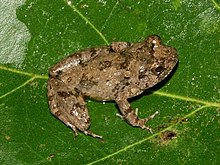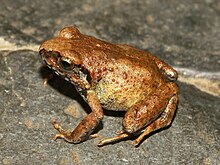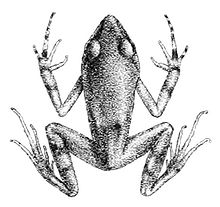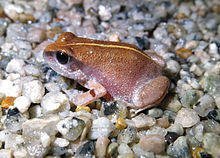Long finger frogs
| Long finger frogs | ||||||||||||
|---|---|---|---|---|---|---|---|---|---|---|---|---|

|
||||||||||||
| Systematics | ||||||||||||
|
||||||||||||
| Scientific name | ||||||||||||
| Arthroleptidae | ||||||||||||
| Mivart , 1869 |
The long finger frogs (Arthroleptidae) form a family of the frogs (Anura). They occur in continental Africa south of the Sahara . Two species are endemic to the islands of Príncipe and Bioko in the Gulf of Guinea .
description
Most of them are smaller frogs. Some species of the genus Arthroleptis reach a head-trunk length of only 15 millimeters. The largest species is Trichobatrachus robustus , the males of which can be 130 millimeters long. This species is the only one in the long-fingered frog family in which the males regularly grow larger than the females.
Another feature, from which the German-language name derives, are the conspicuously elongated fingers of the males in some species of the genera Arthroleptis and Cardioglossa . The third finger is two to three times longer than the rest of the fingers. This form of sexual dimorphism is not found in any other frogs. Their function is unclear.
In the genera Astylosternus , Scotobleps and Trichobatrachus , both males and females have claws on their legs. These are the end links of the toes that pierce the skin and are used for defense. In addition, Trichobatrachus males have thin, thread-like skin structures that look like hair and appear on the flanks and thighs. The only species in the genus, Trichobatrachus robustus , is therefore also called the hair frog . The function of these skin attachments has not yet been finally clarified. On the one hand, they increase the surface area for skin respiration , as they are well supplied with blood, on the other hand, they could serve as protection against injuries in rival fights between the males during the mating season.
The frogs have eight presacral vertebrae, the first two are not, as in many other frog families, fused together. The sternum is partly cartilaginous, which distinguishes the Arthroleptidae from the Ranidae , to which they were often included in the past. The Ranidae have an ossified sternum.
The coloring of most species is inconspicuous and includes browns and gray tones, but some species of the genera Leptodactylodon , Cardioglossa and Leptopelis ( forest climber frogs ) are vividly colored. Some forest climber frogs have very large, red or yellow colored eyes. The color patterns of the species of the Cardioglossa genus make them the most colorful amphibians in Africa.
Occurrence
Only two genera, namely Arthroleptis and Leptopelis, occur in southern and eastern Africa, the others are common in western and central Africa. The genera Leptodactylodon , Nyctibates , Scotobleps and Trichobatrachus live exclusively in the lower-lying forest areas around the Gulf of Guinea . Leptopelis palmatus lives as an endemic on the island of Príncipe , which lies in front of this gulf . Also endemic is the species Arthroleptis bioko , which was discovered on the island of Bioko , which belongs to Equatorial Guinea and is also located in the Gulf of Guinea, and was described in 2010. Other species of the genera Arthroleptis and Leptopelis also live on Bioko, but they are also found on the mainland. Arthroleptis bioko occurs up to an altitude of 1820 meters, the height distribution of the entire family is between sea level and 2700 meters above sea level.
Way of life
Most members of the family show a tadpole phase , but there are also those with a direct larval development within the eggs, from which finished young frogs finally hatch. This is the case with all species of the eponymous genus Arthroleptis and presumably some of the Leptopelis species. Many long-finger frogs live in forests, some species are also found in moist grasslands. Most species live on the ground in the leaf litter, but forest climber frogs (genus Leptopelis ) are mainly found on trees. The only 2.5 centimeter long cave frog ( Arthroleptis troglodytes ) lives in caves and under stones.
The frogs feed on various arthropods that they find in the litter, some larger species mainly eat freshwater snails.
Systematics and taxonomy
The long finger frogs belong together with the related short-headed frogs (Brevicipitidae), the Hemisotidae and the reed frogs (Hyperoliidae) to the Afrobatrachia .
Subfamilies

There are currently three subfamilies. The most species-rich, the Arthroleptinae, used to be placed either with the real frogs (Ranidae) or with the reed frogs (Hyperoliidae). At times the genera of the former Astylosternidae family (including the hair frog ) were integrated into the Arthroleptinae; later the former was raised again to the subfamily rank as Astylosterninae, as it had been identified as the sister group of all other long-fingered frogs. The third subfamily, the forest climber frogs (Leptopelinae), which used to belong to the reed frogs (Hyperoliidae) for a long time, is phylogenetically possibly within the Arthroleptinae. The systematics of the Arthroleptidae is still considered to be unsatisfactory.
species
In the reference list Amphibian Species of the World , the family includes 149 species.
As of May 25, 2020
Subfamily Arthroleptinae Mivart , 1869 (67 species)
- Genus Arthroleptis Smith , 1849 (48 species)
- Arthroleptis adelphus Perret , 1966
- Arthroleptis adolfifriederici Nieden , 1911
- Arthroleptis affinis Ahl , 1939
- Arthroleptis anotis Loader , Poynton , Lawson , Blackburn & Menegon , 2011
- Arthroleptis aureoli ( Schiøtz , 1964)
- Arthroleptis bioko Blackburn , 2010
- Arthroleptis bivittatus Müller , 1885
- Arthroleptis brevipes Ahl , 1924
- Arthroleptis carquejai Ferreira , 1906
- Arthroleptis crusculum Angel , 1950
- Arthroleptis fichika Blackburn , 2009
- Arthroleptis formosus Rödel , Kouamé , Doumbia & Sandberger , 2011
- Arthroleptis francei Loveridge , 1953
- Arthroleptis hematogaster ( Laurent , 1954)
- Arthroleptis kidogo Blackburn , 2009
- Arthroleptis krokosua Ernst , Agyei & Rödel , 2008
- Arthroleptis kutogundua Blackburn , 2012
- Arthroleptis lameerei De Witte , 1921
- Arthroleptis langi Rödel , Doumbia , Johnson & Hillers , 2009
- Arthroleptis loveridgei De Witte , 1933
- Arthroleptis mossoensis ( Laurent , 1954)
- Arthroleptis nguruensis Poynton , Menegon & Loader , 2009
- Arthroleptis nikeae Poynton , 2003
- Arthroleptis nimbaensis Angel , 1950
- Arthroleptis nlonakoensis (Plath , Herrmann & Böhme , 2006)
- Arthroleptis palava Blackburn , Gvoždik & Leaché , 2010
- Arthroleptis perreti Blackburn , Gonwouo , Ernst & Rödel , 2009
- Arthroleptis phrynoides ( Laurent , 1976)
- Arthroleptis poecilonotus Peters , 1863
- Arthroleptis pyrrhoscelis Laurent , 1952
- Arthroleptis reichei Nieden , 1911
- Arthroleptis schubotzi Nieden , 1911
- Arthroleptis spinalis Boulenger , 1919
- Arthroleptis stenodactylus pepper , 1893
- Arthroleptis stridens (Pickersgill , 2007)
- Arthroleptis sylvaticus ( Laurent , 1954)
- Arthroleptis taeniatus Boulenger , 1906
- Arthroleptis tanneri Grandison , 1983
- Arthroleptis troglodytes Poynton , 1963
- Arthroleptis tuberosus Andersson , 1905
- Arthroleptis variabilis Matschie , 1893
- Arthroleptis vercammeni ( Laurent , 1954)
- Arthroleptis wagneri FitzSimons , 1930
- Arthroleptis wahlbergii Smith , 1849
- Arthroleptis xenochirus Boulenger , 1905
- Arthroleptis xenodactyloides Hewitt , 1933
- Arthroleptis xenodactylus Boulenger , 1909
- Arthroleptis zimmeri ( Ahl , 1925)
- Genus Cardioglossa Boulenger , 1900 - Herzzüngler (19 species)
- Cardioglossa alsco Herrmann , Herrmann , Schmitz & Böhme , 2004
- Cardioglossa annulata Hirschfeld , Blackburn , Burger , Zassi-Boulou & Rödel , 2015
- Cardioglossa congolia Hirschfeld , Blackburn , Greenbaum & Rödel , 2015
- Cardioglossa cyaneospila Laurent , 1950
- Cardioglossa elegans Boulenger , 1906
- Cardioglossa escalerae Boulenger , 1903
- Cardioglossa gracilis Boulenger , 1900
- Cardioglossa gratiosa Amiet , 1972
- Cardioglossa inornata Laurent , 1952
- Cardioglossa leucomystax ( Boulenger , 1903)
- Cardioglossa manengouba Blackburn , 2008
- Cardioglossa melanogaster Amiet , 1972
- Cardioglossa nigromaculata Nieden , 1908
- Cardioglossa occidentalis Blackburn , Kosuch , Schmitz , Burger , Wagner , Gonwouo , Hillers & Rödel , 2008
- Cardioglossa oreas Amiet , 1972
- Cardioglossa pulchra Schiøtz , 1963
- Cardioglossa schioetzi Amiet , 1982
- Cardioglossa trifasciata Amiet , 1972
- Cardioglossa venusta Amiet , 1972
Subfamily Astylosterninae Noble , 1927 (30 species)
- Genus Astylosternus Werner , 1898 (12 species)
- Astylosternus batesi ( Boulenger , 1900)
- Astylosternus diadematus Werner , 1898
- Astylosternus fallax Amiet , 1978
- Astylosternus laticephalus Rödel , Hillers , Leaché , Kouamé , Ofori-Boateng , Diaz & Sandberger , 2012
- Astylosternus laurenti Amiet , 1978
- Astylosternus montanus Amiet , 1978
- Astylosternus nganhanus Amiet , 1978
- Astylosternus occidentalis Parker , 1931
- Astylosternus perreti Amiet , 1978
- Astylosternus ranoides Amiet , 1978
- Astylosternus rheophilus Amiet , 1978
- Astylosternus schioetzi Amiet , 1978
- Genus Leptodactylodon Andersson , 1903 (15 species)
- Leptodactylodon albiventris ( Boulenger , 1905)
- Leptodactylodon axillaris Amiet , 1971
- Leptodactylodon bicolor Amiet , 1971
- Leptodactylodon blanci Ohler , 1999
- Leptodactylodon boulengeri Nieden , 1910
- Leptodactylodon bueanus Amiet , 1981
- Leptodactylodon erythrogaster Amiet , 1971
- Leptodactylodon mertensi Perret , 1959
- Leptodactylodon ornatus Amiet , 1971
- Leptodactylodon ovatus Andersson , 1903
- Leptodactylodon perreti Amiet , 1971
- Leptodactylodon polyacanthus Amiet , 1971
- Leptodactylodon stevarti Rödel & Pauwels , 2003
- Leptodactylodon ventrimarmoratus ( Boulenger , 1904)
- Leptodactylodon wildi Amiet & Dowsett-Lemaire , 2000
- Genus Nyctibates Boulenger , 1904 (with only one species)
- Nyctibates corrugatus Boulenger , 1904
- Genus Scotobleps Boulenger , 1900 (with only one species)
- Scotobleps gabonicus Boulenger , 1900
- Genus Trichobatrachus Boulenger , 1900 (with only one species)
- Trichobatrachus robustus Boulenger , 1900 - hair frog
Subfamily Leptopelinae Laurent , 1972
- Genus Leptopelis Günther , 1859 - Forest climber frogs (53 species, listed there)
The species Arthroleptis lonnbergi was placed as Mertensophryne lonnbergi in the genus Mertensophryne of the family Bufonidae . Arthroleptis wagneri was removed from the synonymy with Arthroleptis wahlbergi , in which it was placed in 1954, and recognized as a separate species in 2018 . Cardioglossa aureoli has been classified into the genus Arthroleptis (see above).
Individual evidence
- ↑ a b c d e f David C. Blackburn: Family Arthroleptidae . Amphibiaweb, University of California, Berkeley, CA 2000–2020, accessed May 25, 2020.
- ↑ Breda M. Zimkus & David C. Blackburn: Distinguishing features of the sub-Saharan frog genera Arthroleptis and Phrynobatrachus: a short guide for field and museum researchers. Breviora, Museum of Comparative Zoology, 513, pp. 1-12, Cambridge, Massachusetts 2008.
- ↑ David C. Blackburn, James Hanken, Farish A. Jenkins Jr: Concealed weapons: erectile claws in African frogs Biological Letters 4, 2008; Pp. 355-357; ( PDF )
- ↑ Heather Heying: Arthroleptidae . Animal Diversity Web, University of Michigan, 2003, accessed May 25, 2020.
- ↑ Sayer Jeffrey Sayer (Ed.): The Conservation Atlas of Tropical Forests: Africa . Macmillan, 1992, ISBN 978-1-349-12963-8 , p. 243.
- ↑ David C. Blackburn: A New Squeaker Frog (Arthroleptidae: Arthroleptis) from Bioko Island, Equatorial Guinea. Herpetologica, 66, pp. 320-334, 2010.
- ↑ a b Daniel Portik & David C. Blackburn: The evolution of reproductive diversity in Afrobatrachia: A phylogenetic comparative analysis of an extensive radiation of African frogs. Evolution, 70, 9, pp. 2017-2032, September 2016.
- ↑ a b Darrel R. Frost: Arthroleptidae Mivart, 1869 . Amphibian Species of the World: an Online Reference, Version 6.1, American Museum of Natural History, New York 1998-2020, accessed May 25, 2020.
- ^ SP Loader, JC Poynton, LP Lawson, DC Blackburn & M. Menegon: Herpetofauna of montane areas of Tanzania. 3. Amphibian diversity in the northwestern Eastern Arc Mountains, with the description of a new species of Arthroleptis (Anura: Arthroleptidae). Fieldiana. Life and Earth Sciences, 4, pp. 90-102, 2011
- ↑ a b D. C. Blackburn: Biogeography and evolution of body size and life history of African frogs: Phylogeny of squeakers (Arthroleptis) and long-fingered frogs (Cardioglossa) estimated from mitochondrial data. Molecular Phylogenetics and Evolution, 49, pp. 806-826, 2008
- ^ V. FitzSimons: Descriptions of new South African Reptilia and Batrachia, with distribution records of allied species in the Transvaal Museum collection. Annals of the Transvaal Museum 14 pp. 20–48, 1930.
- ↑ Darrel R. Frost, Taran Grant, Julián Faivovich, Raoul H. Bain, Alexander Haas, Celio FB Haddad, Rafael O. de Sá, A. Channing, Mark Wilkinson, Stephen C. Donnellan, Christopher J. Raxworthy, Jonathan A. Campbell, Boris L. Blotto, Paul E. Moler, Robert C. Drewes, Ronald A. Nussbaum, John D. Lynch, David M. Green, and Ward C. Wheeler: The amphibian tree of life. Bulletin of the American Museum of Natural History, 297, pp. 1-370, 2006 full text
- ^ A. Loveridge: New frogs of the genera Hyperolius and Arthroleptis from South Africa. Annals of the Natal Museum, 13, pp. 95-99, 1954
- ^ Tolley, KA, W. Conradie, J. Harvey, GJ Measey, and DC Blackburn: Molecular phylogenetics reveals a complex history underlying cryptic diversity in the Bush Squeaker Frog (Arthroleptis wahlbergii) in southern Africa. African Zoology, 53, pp. 83-97, 2018
Web links
- Darrel Frost: Arthroleptidae Mivart, 1869 . In: Amphibian Species of the World: an Online Reference . Version 6.1. American Museum of Natural History, New York 1998-2020, accessed May 25, 2020
- Amphibiaweb: List of species of the Arthroleptidae family
- Arthroleptis in the IUCN Red List of Threatened Species2018.
- Astylosternus in the IUCN 2018Red List of Threatened Species.
- Cardioglossa in the IUCN 2018Red List of Threatened Species.
- Leptodactylodon in the IUCN Red List of Threatened Species2018.
- Nyctibates in the IUCN 2018Red List of Endangered Species.
- Scotobleps in the IUCN 2018Red List of Threatened Species.
- Trichobatrachus in the IUCN 2018Red List of Threatened Species.
- Leptopelis in the IUCN 2018Red List of Threatened Species.








